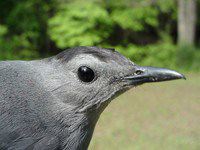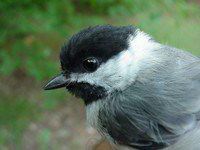 HOME: www.hiltonpond.org |
|
||
|
|
|||
|
|
|||
|
|
|||
|
|
|||
|
|
|||
|
THIS WEEK at HILTON POND |
|
By Night (And Day) One night this week we were looking for frogs at Hilton Pond Center. As we scanned the banks of the pond with powerful flashlight, bright spots on several shrubs stood out in the darkness. On closer examination, we found the spots to be clusters of dense white fluff, and beside each was a red insect. We had discovered a herd of aphids being tended by ants.  Aphids are tiny insects in the Homoptera, the class that includes cicadas, leaf hoppers, and scale insects. (Some taxonomists put them in the Hemiptera with the "true bugs.") All feed on plants, from which they suck nutritious juices with their specialized mouthparts. At Hilton Pond Center, Hazel Alder (Alnus serrulata) is frequently colonized by the Woolly Alder Aphid (Prociphilus tessellatus), which usually overwinters on maples (Acer spp.) in the egg stage or as tight masses of adults. Newly-emerged aphids settle on midveins of fresh, tender maple leaves, where females reproduce asexually to make very large colonies. The winged generation that develops flies in July to alders--on which several successive generations may reproduce--but some adults fly back to maple trunks and branches, where they mate and produce one egg per aphid. Thus, maples are considered to be the primary host and alders the secondary host. (Incidentally, some species of aphids are moved from one plant to another by their caretaker ants--especially after the aphids have sucked a host plant dry.)
Aphids apparently are not very good at digesting all the plant sugars they ingest, and they excrete large quantities of sweet "honeydew" from their anuses. This fluid, in turn, attracts ants that drink up the honeydew as an easily acquired carbohydrate source. Many ant species go so far as to "herd" aphids and protect them from potential predators such as labybugs and the caterpillar of the Harvester butterfly (Feniseca tarquinius). Ants seem to be less effective at driving away other aphid predators such as hoverflies and lacewings.
Woolly Alder Aphids appear to have little impact on their host trees, but anyone who has ever parked a new car beneath an aphid-infested maple knows just how many droplets of honeydew a colony of these tiny little insects can actually produce.
If you enjoy "This Week at Hilton Pond," please help Support Hilton Pond Center for Piedmont Natural History |
 Woolly Alder Aphids secrete a covering of dense, white, cottony material and long, waxy white threads on their backs (right). On leaves of the host plant, females produce a colony of bluish-black or green aphids, also covered with wax threads. Together, all these aphids form the large, white, woolly masses found on the underside of curled maple leaves or on alder leaves or twigs. The aphids drink up large quantities of sap from leaves, causing them to curl and form a protective umbrella.
Woolly Alder Aphids secrete a covering of dense, white, cottony material and long, waxy white threads on their backs (right). On leaves of the host plant, females produce a colony of bluish-black or green aphids, also covered with wax threads. Together, all these aphids form the large, white, woolly masses found on the underside of curled maple leaves or on alder leaves or twigs. The aphids drink up large quantities of sap from leaves, causing them to curl and form a protective umbrella. Although ants can be found tending aphids during daylight, at Hilton Pond Center they seem to be more active by night (left), when they each spend several hours consuming so much honeydew that their semi-transparent abdomens swell to twice normal size.
Although ants can be found tending aphids during daylight, at Hilton Pond Center they seem to be more active by night (left), when they each spend several hours consuming so much honeydew that their semi-transparent abdomens swell to twice normal size.



